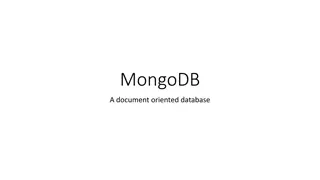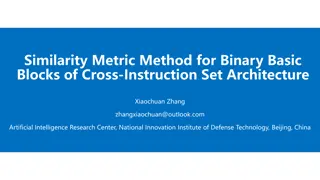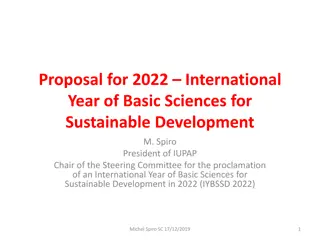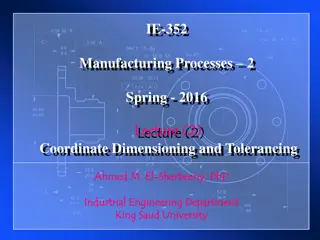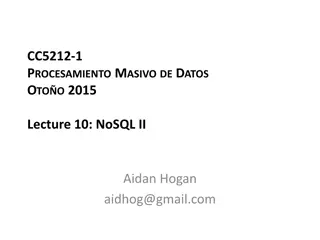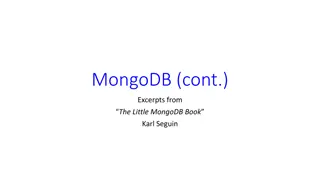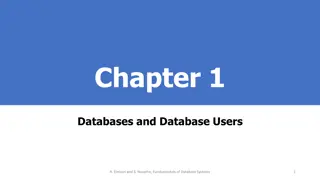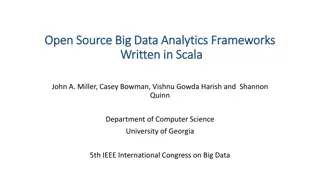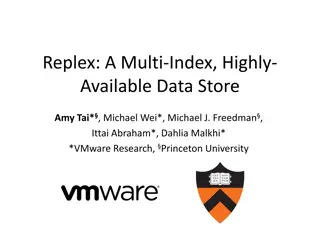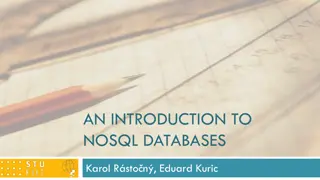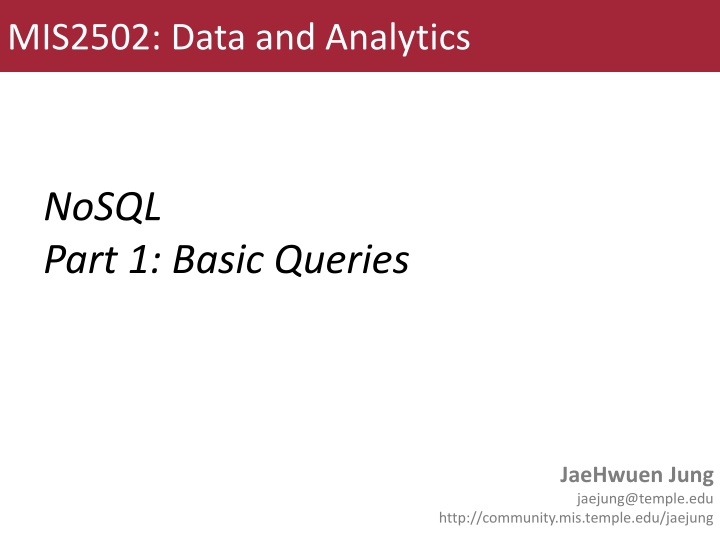
NoSQL Data and Analytics: Understanding the Basics of Non-Relational Databases
Explore the fundamentals of NoSQL databases, including their advantages over traditional relational databases, the key differences between RDBMS and NoSQL, and the unique features of MongoDB. Learn why organizations choose NoSQL for handling semi-structured data and big data challenges, and discover how to determine whether RDBMS or NoSQL is the right fit for your data needs.
Download Presentation

Please find below an Image/Link to download the presentation.
The content on the website is provided AS IS for your information and personal use only. It may not be sold, licensed, or shared on other websites without obtaining consent from the author. If you encounter any issues during the download, it is possible that the publisher has removed the file from their server.
You are allowed to download the files provided on this website for personal or commercial use, subject to the condition that they are used lawfully. All files are the property of their respective owners.
The content on the website is provided AS IS for your information and personal use only. It may not be sold, licensed, or shared on other websites without obtaining consent from the author.
E N D
Presentation Transcript
MIS2502: Data and Analytics NoSQL Part 1: Basic Queries JaeHwuen Jung jaejung@temple.edu http://community.mis.temple.edu/jaejung
Where we are Now we re here Data entry Data Data analysis extraction Transactional Database Analytical Data Store Stores real-time transactional data in a relational or NoSQL database Stores historical transactional and summary data
What is NoSQL? Stands for Not Only SQL Non-relational data storage systems Supports unstructured format (no fixed schema)
Why RDBMS? Relational Databases popular and commonly used Minimize redundancy - Reduce errors - Less space required Supports Joins - across multiple tables allowing for normalized forms of data to be stored once
Why NoSQL? Supports semi-structured (unstructured) data - Unique data type extensions can be easily integrated into existing collections Handling Big data with better performance - RDBMS normalization and joins are powerful, but add up in cost Operational issues (scale, performance and availability)
RDBMS vs. NoSQL RDBMS NoSQL Pre-defined schema Flexible schema Data is distributed across multiple tables Data is typically nested in a few collection Based on relations (Very few) relations Not good for hierarchical work Best fit for hierarchical work
NoSQL vs RDBMS How to pick? Nature of data Row/column (structured) Unstructured, complex which needs nesting Schema Static: RDBMS, Dynamic: NoSQL Self-contained: NoSQL, Joins: RDBMS Flexibility of query RDBMS: Joins allow for flexibility NoSQL: Duplication of data, implement joins if necessary
What is MongoDB? MongoDB is Created by 10gen (term coined from humongous) an open source, document-oriented database design stores BSON (JSON-like) documents Schema-less
MongoDB Database Database Collection Collection Document Document Document Document Document MongoDB RDBMS Database Database Collection Table Field Column Document Row Embedded Document Linking across Document Join Reference Foreign Key
Connecting to a MongoDB Server Before you open the compass, copy the connection string below: mongodb+srv://username:password@cluster0.4eq2c.mongodb.net/test Click yes and type in your username and password. You can use the same username and password you used to connect MySQL.
Dataset salesdb.sales JSON array JSON object
Aggregation Tab Aggregation tap allows us to create pipeline stages, which specifies multiple stages of queries, to return a subset of documents from collection. Select a type of stage Add a new stage
MySQL vs MongoDB Query MySQL MongoDB WHERE $match GROUP BY $group ORDER BY $sort LIMIT $limit SELECT expressions FROM.. $project Example.. SELECT purchaseMethod, sum(price) as totalprice FROM salesDB.sales WHERE couponUsed = FALSE GROUP BY purchaseMethod ORDER BY sum(price) ASC LIMIT 2; db.sales.aggregate( [ { $match: { couponUsed: FALSE }}, { $group: { _id: "$purchaseMethod", totalprice: { $sum: "$price" }}}, { $sort: { totalprice: 1 }}, { $limit: 2 } ])
Return the Specified Fields Select $project stage and copy the following expression into the panel: $project: { items: 1, storeLocation: 1, customer: 1 } The operation corresponds to the following SQL statement: SELECT items, storeLocation, customer FROM salesdb.sales; The _id field is, by default, included in the output documents. You can remove by setting the field to 0. Ref: https://docs.atlas.mongodb.com/data-explorer/cloud-agg-pipeline
Specify Equality Condition documents that match the specified condition(s) $match stage filters the documents to pass only the Syntax : $match: { field1: value1, ... } The below code corresponds to the following SQL statement: $match: { storeLocation: "Seattle"} SELECT items, storeLocation, customer FROM salesdb.sales WHERE storeLocation = Seattle ; $match work as WHERE statement in a SQL query.
Compass vs MongoDB Compass $project: { items: 1, storeLocation: 1, customer: 1 } $match: { storeLocation: "Seattle"} MongoDB Click Export To Language to see the code. db.sales.aggregate{ [{ $project: {items: 1,storeLocation:1,customer:1}}, { $match: {storeLocation: "Seattle"}}] }
Does order matter? What happens when we type in the following code? What happens when we switch the order of $project and $match? $ project: { items: 1, customer: 1 } $ match: { storeLocation: Seattle } Unlike SQL, in the aggregation pipeline, each stage transforms the documents as they pass through the pipeline. Therefore, order matters!!!
Specify Conditions Using Operators Syntax : $match: { field1: { operator1: value1 }, ... } For example, $match: { price: { $gt: 200 } } corresponds to the following SQL statement: SELECT * FROM MIS2502.sales WHERE price > 200; Name Description Name Description $eq equal to $lt less than $gt greater than $lte less than or equal to $gte greater than or equal to $ne not equal to
AND and OR Conditions Syntax : $match: { $and(or) : [ { condition1 }, { condition2 } , } ] } $and and $or operator performs a logical operation on an array of two or more <conditions>. $match: { $and: [{ price: { $gt: 180} } , { storeLocation: "Seattle"}]} The operation corresponds to the following SQL statement: SELECT * FROM salesDB.sales WHERE price > 180 AND storeLocation = Seattle ;
Sort Results Using $sort stage, we can specify the sort order of the returned documents. $sort: { price: 1 } The operation corresponds to the following SQL statement: SELECT * FROM salesDB.sales ORDER By price ASC; We can set the field to 1 (-1), to specify ascending (descending) order for a field,.
Limit Results Using $limit stage, we can specify the number of the returned documents. $limit: 3 The operation corresponds to the following SQL statement: SELECT * FROM salesDB.sales LIMIT 3; So, what may happen if we put $limit on the first stage?
Aggregation $group documents by some specified expression and outputs to the next stage a document for each distinct grouping Syntax : $group: { _id: expression, field1: {accumulator1:expression1}, ... } $group: { _id: "$purchaseMethod", totalprice: { $sum: "$price"} } corresponds to the following SQL statement: SELECT purchaseMethod, sum(price) as totalprice FROM salesDB.sales Group by purchaseMethod;
Aggregation Similar to GROUP BY in SQL, the output documents can contain computed filed $group: { _id: "$purchaseMethod", totalprice: { $sum: "$price"}, avgprice: { $avg: "$price"}, maxprice: { $max: "$price"}, number: { $sum:1} } corresponds to the following SQL statement: SELECT purchaseMethod, sum(price) as totalprice, avg(price) as avgprice, max(price) as maxprice, count(price) as number FROM salesDB.sales Group by purchaseMethod; In $group, we use $sum: 1 to count the number of documents.
Group by null Grouping _id with null will calculate the total price and the average quantity as well as counts for all documents in the collection. $group: { _id: null, totalprice: { $sum: "$price"}, avgprice: { $avg: "$price"}, maxprice: { $max: "$price"}, number: { $sum:1} } corresponds to the following SQL statement: SELECT sum(price) as totalprice, avg(price) as avgprice, max(price) as maxprice, count(price) as number FROM salesDB.sales;
MySQL vs MongoDB Query MySQL MongoDB WHERE $match GROUP BY $group ORDER BY $sort LIMIT $limit SELECT expressions FROM.. $project Example.. SELECT purchaseMethod, sum(price) as totalprice FROM salesDB.sales WHERE couponUsed = FALSE GROUP BY purchaseMethod ORDER BY sum(price) ASC LIMIT 2; db.sales.aggregate( [ { $match: { couponUsed: FALSE }}, { $group: { _id: "$purchaseMethod", totalprice: { $sum: "$price" }}}, { $sort: { totalprice: 1 }}, { $limit: 2 } ])
Summary Given a semi structured database, we now should be able to create a NoSQL statement to answer a question Understand how each stage in aggregation tap works and the relationship with SQL keywords $project $match $sort $limit $group
Syntax for MongoDB KEY : Value Field name (e.g., customer) Numeric value Field name with dot notation (e.g., customer.name ) String value (e.g., Seattle ) $accumulator/operator (e.g., $sum, $gt) $Field name (e.g., $customer ) $project: { items: 1, storeLocation: 1, customer: 1 } $match: { $and: [{ price: { $gt: 180} } , { storeLocation: "Seattle"}]} $group: { _id: "$purchaseMethod", totalprice: { $sum: "$price"} }


